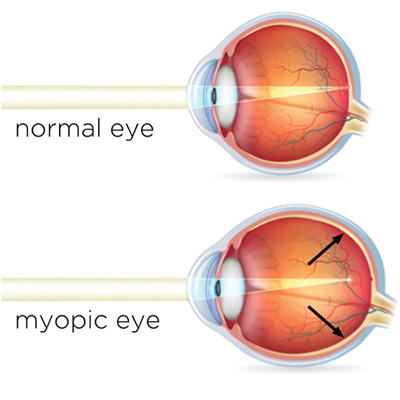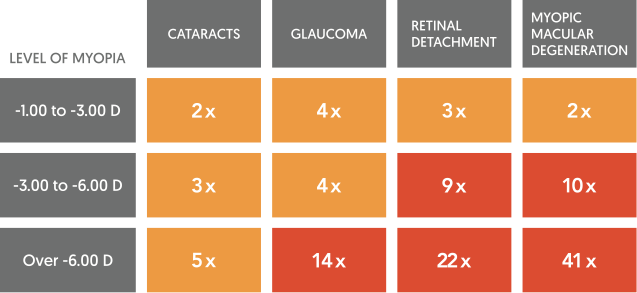What is Myopia?
Myopia (also known as nearsightedness) develops when the eye grows too long from front to back, which causes light to focus in front of the retina rather than directly on it. For those with nearsightedness, distant objects appear blurred while nearby objects remain clear.
This condition develops during childhood, when the eyeballs are experiencing rapid growth, and tends to progress gradually or rapidly into the late teen years. Myopia can be easily corrected using corrective glasses or contact lenses.
Childhood myopia is typically diagnosed between the ages of 5 and 7 and worsens during the eye’s rapid growth years. The prescription tends to plateau at around age 12.

Over 10 million U.S. children already have myopia. By 2050, half the world’s population will have myopia.
In the US, diagnoses of myopia in children has doubled over the course of just a single generation.
What’s worse, researchers now predict that by 2050 the incidence of myopia will increase by a further 40% over today’s epidemic-levels of occurrence. This would translate into almost 60 million kids under the age of 17 suffering from myopia.
As parents, it is alarming to see our child’s vision deteriorate every year. Parents who remember getting glasses themselves feared it was just a matter of time before their children needed them too. But the rate and severity of myopia is growing so significantly that researchers believe there are other contributing factors beyond genetics.
What Are The Risks Becoming More Myopic?
Age: Rate of myopia onset is associated with age, with onset at younger age leading to higher risk of developing high myopia.
Parent’s Myopia: There isn’t a definitive hereditary association but research has shown that there is greater risk of myopia development if parents are myopic.
Prescription Changes: If your child’s prescription makes a large change, the myopia will likely to continue to change with age.
Close Work: Risk of myopia progression is usually higher the more the child reads and does near work.
The Dangers of Myopia
We once believed the worst part of myopia was declining vision and stronger glasses. We now know there’s more to worry about than ever-thickening lenses.
It is clinically proven that more severe myopia leads to a significant increase in the risk of more serious eye diseases later in life. Diseases like macular degeneration, retinal detachment, cataracts and glaucoma, which can all lead to blindness.
Until recently, researchers believed that only severely advanced cases of myopia could be blamed for patients developing severe eye diseases. Recent studies confirm an increase in the risk of more serious eye diseases from any amount of myopia.
Leading researchers now believe there is no safe amount of myopia, no matter how small.

